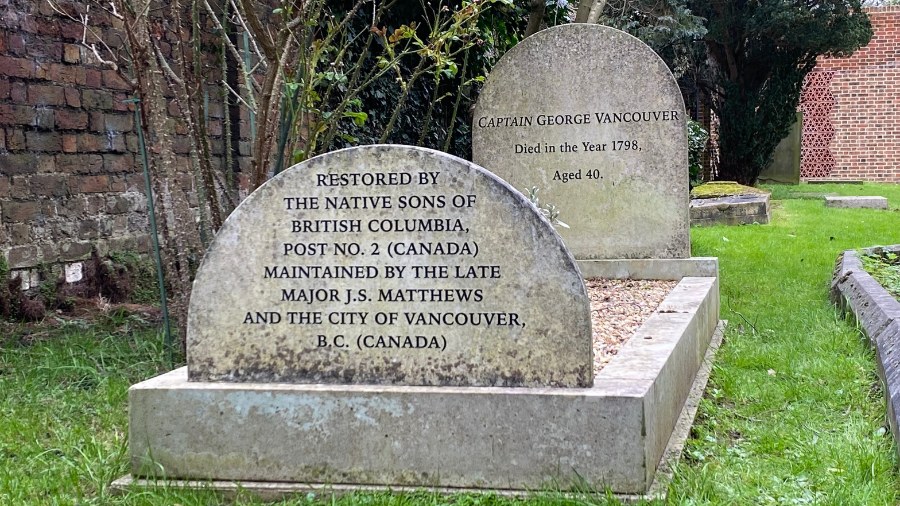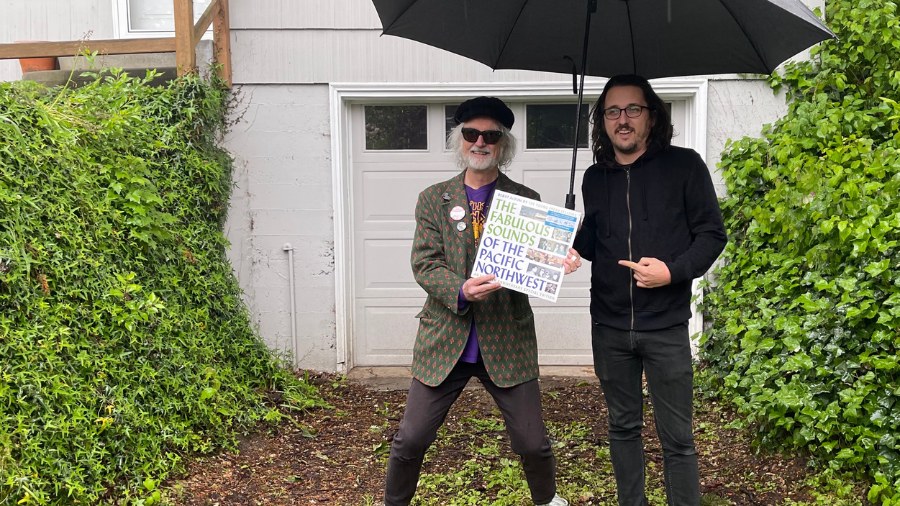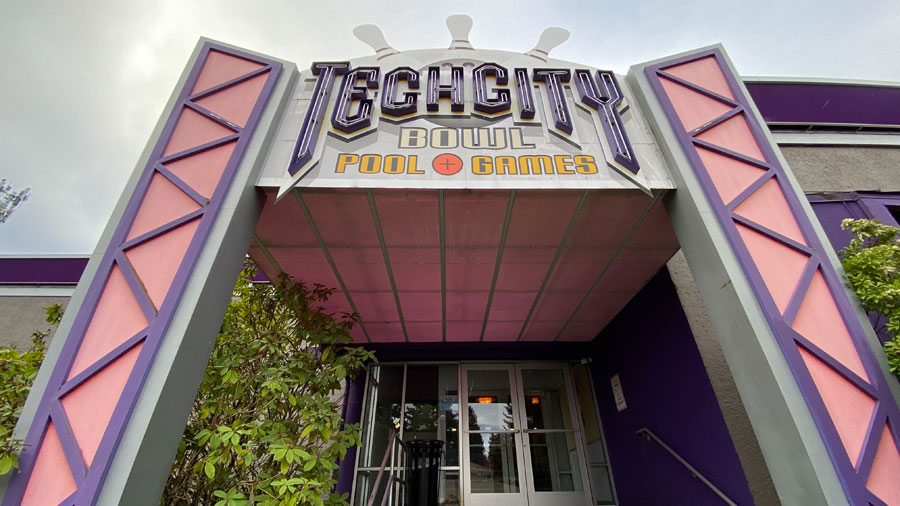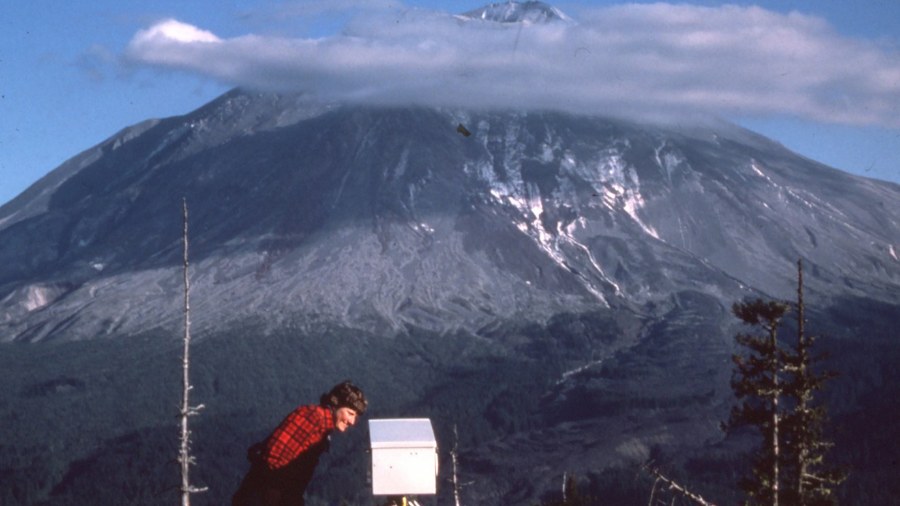Visiting Captain Vancouver’s grave in a tiny village near London
May 8, 2024, 1:31 PM | Updated: 11:15 pm

Captain George Vancouver is buried in a churchyard in Petersham Village, west of London. (Photo: Feliks Banel, KIRO Newsradio)
(Photo: Feliks Banel, KIRO Newsradio)
This weekend, in a tiny village near London, Captain George Vancouver will be commemorated as he is every year at the centuries-old churchyard where he was buried more than 225 years ago.
You can’t go very far around here without tripping over geographic features – Mount Baker, Mount Rainier, Puget Sound – that were named by Captain Vancouver when he explored the Northwest back in 1792. Vancouver was very young when he led an expedition to the Northwest Coast of North America – just 34 years old – that changed the course of history in the Pacific Northwest, and that irrevocably altered the Indigenous civilization that had called this region home since time immemorial.
In April 1792, Captain Vancouver sailed right past the mouth of that big river south of here – infamously failing to enter and explore what became known as the Columbia River, and lost out on that prize to an American named Robert Gray who explored and named the river just a few weeks later. Vancouver’s oversight had long-lasting political ramifications that some say led the United States to eventually take possession of what’s now Washington, Oregon and California.
However, Vancouver did sail HMS DISCOVERY through the Strait of Juan de Fuca and then became the first non-Indigenous person to explore what he named Puget’s Sound. Vancouver and his crew spent most of May 1792 surveying these waters and placing names we still use today, though there are moves afoot to restore Indigenous names to places such as Mount Rainier.
At the end of his years-long voyage, Vancouver returned to England to work on creating nautical charts from the surveys he had led, and writing the narrative of the expedition (based on journals he kept during the expedition). Unfortunately, that work had to be completed by his brother John because George Vancouver died in the spring of 1798 at age 40.
Captain Vancouver’s burial spot
Captain Vancouver is buried at St. Peter’s Church in Petersham. It’s a lovely spot west of London, readily accessible by mass transit, on the outskirts of the town of Richmond and not far from the Thames River.
Jean Allsopp is church historian for St. Peter’s. It’s an understatement to say that she has a bounty of material to work with.
“The churchyard goes all the way back for many, many centuries,” Allsopp told KIRO Newsradio. “The earliest graves that we have on record, those date to the 1700s.”
“But we have three layers of burial there” – that is, unrecorded burials going back much, much further – “so it’s very, very old,” Allsopp said.
While not a major tourist attraction, the churchyard and the quiet village of Petersham are worth the effort to visit.
“I think the initial impact that most people get, is that of peace and it’s just so tranquil,” Allsopp said.
The spot where Captain Vancouver is buried is near a high wall and takes a few minutes to find. Trees grow around edge of the churchyard and in several places within; the grass is dense, and many of the headstones are small and faded and difficult to read, while others are large and monumental. Vancouver’s headstone is on the more modest side, and the actual stone is a relatively recent creation, made to replace an earlier version.
“A lot of people choose to go and just sit on some of the benches and just enjoy the peace and quiet, really,” Allsopp said.
Why is the captain buried in Petersham?
A question that naturally comes to mind is why Captain Vancouver would be buried in Petersham, which is a place not generally associated with seafaring explorers or with the Royal Navy.
Jean Allsopp says that when Captain Vancouver returned to England in September 1795, he was terminally ill. What he was suffering from is a bit of a mystery – but it may have been tuberculosis.
As for why he’s buried in Petersham, the Royal Navy apparently “billeted” him – that is, assigned him living quarters – in the nearby town of Richmond at a famous pub on Richmond Hill called The Star and Garter. This billeting was so that Vancouver could have a dedicated place to finish the editing and other work required before the manuscript about his exploration of the Northwest coast could be published.
“At some point, he moved from there down into Petersham Village,” Allsopp said, perhaps because his health had taken a turn for the worse. “He was a very ill man and his two brothers, Charles and John Vancouver, were staying with him and looking after him.”
“He died there, really,” Allsopp said, “and that’s why he’s in our parish church.”
As removed as it is from the sea, Petersham is also nowhere near where George Vancouver was born and raised. Home for the family was a place call King’s Lynn, which is in Norfolk about 120 miles away.
Jean Allsopp says Vancouver’s family was connected to the sea throughout the 18th century, but they were relative newcomers to England. George Vancouver’s grandfather – his father’s father – had emigrated from Holland.
“His father was the customs collector in King’s Lynn, which was a big seaport,” Allsopp said. “And in the case of the Vancouver family, they were all engineers, and they came over to help drain the (wetlands) which were very, very swampy, and to make them good, arable farming land.”
Yearly Captain Vancouver event is happening soon
The annual event commemorating Captain Vancouver will take place Sunday. Allsopp says it’s usually held on or near the anniversary of Vancouver’s burial at Petersham, which took place on May 10, 1798. Sunday’s event traces its origins back to the aftermath of World War II, when the commemoration was first held as a thank-you to Canada for financial support to repair war damage suffered by St. Peter’s Church.
Jean Allsopp says that more than 100 people typically turn out to honor Captain Vancouver, including parishioners, history enthusiasts, Sea Scouts, and some very special VIPs.
In American terms, it sounds like the annual event is a “big deal” at St. Peter’s Church in tiny Petersham.
“It is for a little parish church,” Allsopp agreed, chuckling. “We’re not St. Paul’s Cathedral, but for a parish church like ours, yes, it is.”
“We will have the local mayor attending with the counselors,” Allsopp added, meaning from the nearby town of Richmond. “We have some of the descendants of Captain Vancouver’s brother (John) attending from Holland, they come every year. And we have lots of people with just sea connections.”
The link between Canada – home of Vancouver, British Columbia, of course – and Petersham, resting place of the city’s namesake, remains strong more than two centuries after Captain Vancouver visited what’s now Washington and British Columbia.
“The Naval Attaché for the Canadian High Commission always attends,” Allsopp said. “And he will be laying a wreath on the grave on behalf of Canada.”
Canadian city honors its namesake
As it turns out, the City of Vancouver, British Columbia, has long shown its respect for Captain Vancouver’s final resting place. Volunteers from the Canadian province provided financial support for restoration of the headstone nearly 100 years ago, and the municipal government has contributed to more recent restoration efforts, and to general upkeep.
Johann Chang, a spokesperson for the City of Vancouver wrote in an email that the city “is still providing an annual contribution to the maintenance of Captain George Vancouver’s grave.”
Chang also shared a memo prepared in November 2002 for the Vancouver City Council when they were asked to vote on a measure to support a trust fund for the grave that was first established more than 50 years ago.
“Close ties exist between St. Peter’s Church, Petersham, England, and the City of Vancouver, due largely to the fact that Captain George Vancouver is buried on this Church site,” the memo reads. “Many Canadians visit this site annually as they discover the fascinating life story of Captain Vancouver.”
“Vancouver has traditionally assisted in the maintenance of his grave,” the memo continues. “In 1970, with Council’s approval, a $1,000 Trust Fund was set up, the amount invested in a bond, and the yearly interest generated was sent to St. Peter’s Church to help maintain the grave.”
“The last amount disbursed was $175 (in Canadian dollars), which was sent in 1994 to a Boy Scout troop in Petersham, who at that time were maintaining the grave,” the 2002 memo continues. However, contact has been lost with the group, and consequently, no payments have been made from the Fund since that time. St. Peter’s Church has been maintaining the gravesite since 1994 without financial support from the British Columbia city.
The 2002 measure was approved, and the Vancouver City Council added $15,000 Canadian Dollars to the trust fund. This new funding, and the renewed connection to St. Peter’s Church, meant the city resumed its annual contributions which have continued ever since.
“The 2024 contribution was paid on April 15, 2024,” Johann Chang wrote in an email. “The amount was £265.00, which is equivalent to $519.40 Canadian dollars (or about $378 in the U.S.).
With this annual support and especially with the enthusiasm and dedication of volunteers like church historian Jean Allsopp, St. Peters is to be commended for taking seriously their stewardship role for Captain Vancouver’s grave, and in welcoming visitors there year-round.
“It’s a complete accident that we got him,” Allsopp said. “But we’re very proud of him.”
You can hear Feliks Banel every Wednesday and Friday morning on Seattle’s Morning News with Dave Ross and Colleen O’Brien. Read more from Feliks here and subscribe to The Resident Historian Podcast here. If you have a story idea or a question about Northwest history, please email Feliks. You can also follow Feliks on X, formerly known as Twitter.













